Related Research Articles

Indian Motorcycle is an American brand of motorcycles owned and produced by American automotive manufacturer Polaris Inc.

An outlaw motorcycle club, known colloquially as a bikie gang, biker gang or motorcycle gang, is a motorcycle subculture generally centered on the use of cruiser motorcycles, particularly Harley-Davidsons and choppers, and a set of ideals that purport to celebrate freedom, nonconformity to mainstream culture, and loyalty to the biker group.

A sport bike, sports motorcycle, or sports bike is a motorcycle designed and optimized for speed, acceleration, braking, and cornering on asphalt concrete race tracks and roads. They are mainly designed for performance at the expense of comfort, fuel economy, safety, noise reduction and storage in comparison with other motorcycles.

In the market, there is a wide variety of types of motorcycles, each with unique characteristics and features. Models vary according to the specific needs of each user, such as standard, cruiser, touring, sports, off-road, dual-purpose, scooters, etc. Often, some types like sport touring are considered as an additional category or integrated with touring.

Laconia Motorcycle Week is an annual motorcycle rally held in Laconia, New Hampshire, United States. The rally originated as a motorcycle Gypsy tour in 1916 as, the New Hampshire Lakes Region became a popular riding destination for early motorcycle enthusiasts from New York, Boston, Philadelphia and Montreal. The popularity of the rally led to the formation of the Loudon Classic motorcycle race in 1934 which, became one of the most prestigious races in American motorcycle racing, second only to the Daytona 200. The scheduled events included races, shows and a motorcycle hill climb competition. The rally traditionally takes place over nine days in June, always the 2nd and 3rd full weekend. The rally was the largest annual gathering of North American motorcyclists until it was overtaken by the Sturgis Motorcycle Rally during the 1970s.
A motorcycle rally is a gathering of motorcycle enthusiasts. Rallies can be large or small, and one-time or recurring. Some rallies are ride-in events, whereas some like the Iron Butt Rally involve days of riding and an actual gathering only at the end of the ride.
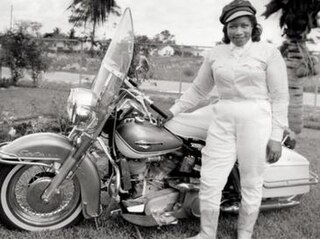
Bessie Stringfield, also known as the "Motorcycle Queen of Miami", was an American motorcyclist who was the first African-American woman to ride across the United States solo, and was one of the few civilian motorcycle dispatch riders for the US Army during World War II.

The Indian Scout is a motorcycle built by the Indian Motocycle Company from 1920 to 1949. It rivaled the Chief as Indian's most important model. The 101 Scout, made from 1928 to 1931, has been called the best motorcycle Indian ever made. A second line of Scouts, with heavier frames, was introduced in 1932 alongside the Standard Scout, which replaced the 101 Scout and shared its frame with the Chief and the Four. The small-displacement Scout and the Sport Scout, introduced in 1934, were continued until the end of civilian production in 1942. Military versions of both models were used by US and other Allied forces during World War II.

Colors are the insignia, or "patches", worn by motorcycle club members on cut-off vests to identify membership of their club and territorial location. Club patches have been worn by many different groups since the 1960s. They are regarded by many to symbolize an elite amongst motorcyclists and the style has been widely copied by other subcultures and commercialized.

The wall of death, motordrome, velodrome or well of death is a carnival sideshow featuring a silo- or barrel-shaped wooden cylinder, typically ranging from 20 to 36 feet in diameter and made of wooden planks, inside which motorcyclists, or the drivers of miniature automobiles and tractors travel along the vertical wall and perform stunts, held in place by friction and centrifugal force. The original wall of death was in 1911 on Coney Island in the United States.

The following outline is provided as an overview of motorcycles and motorcycling:
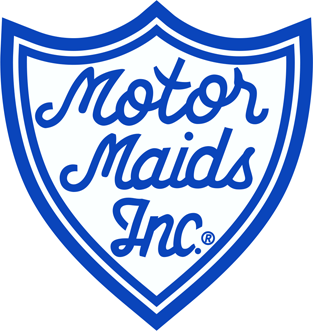
Motor Maids is a women's motorcycle club in North America with over 1,300 members from the United States and Canada. Established in 1940, Motor Maids was one of the first women's motorcycle groups and has been called the oldest existing women's club in the United States. The first president of Motor Maids was Dot Robinson, who held the position for 25 years.
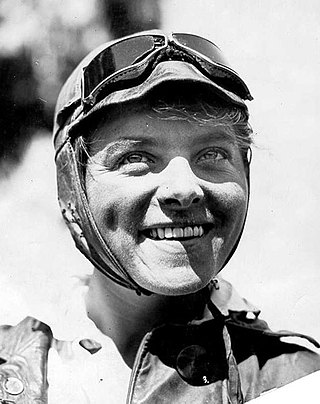
Augusta Van Buren and Adeline Van Buren, sisters, rode 5,500 miles in 60 days to cross the continental United States, each on their own motorcycle, completing on 8 September 1916. In so doing they became the second and third women to drive motorcycles across the entire continent, following Effie Hotchkiss, who had completed a Brooklyn-to-San Francisco route the year before with her mother, Avis, as a sidecar passenger.

The Women's International Motorcycle Association (WIMA) is a motorcycle club established by Louise Scherbyn in 1950 in the United States. Branches began in many countries, including Great Britain and Australia where the branch was started by Hazel Mayes. It was the first organization to recognize all women in the sport, and the first ever stand-alone women-led motorcycle association. Currently spanning 39 countries, it is purportedly the largest motorcycle association for women in the world. The group is known for organising annual "Pink Ribbon Rides" to raise awareness for breast cancer.
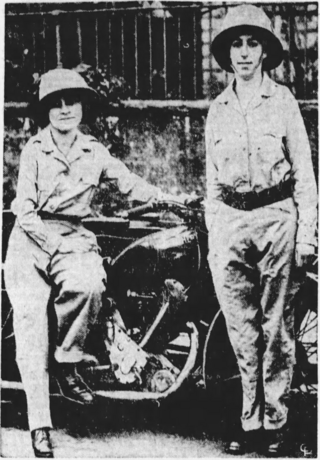
Theresa Wallach was an adventure motorcyclist, engineer, mechanic and author. In 1935 with another experienced motorcyclist named Florence Blenkiron, she rode a 600 cc single-cylinder Panther motorcycle complete with sidecar and trailer, from London to Cape Town, South Africa, crossing the Sahara desert, reportedly without a compass. Wallach was the first Vice President of the Women's International Motorcycle Association, and was inaugurated into the AMA Motorcycle Hall of Fame in 2003.
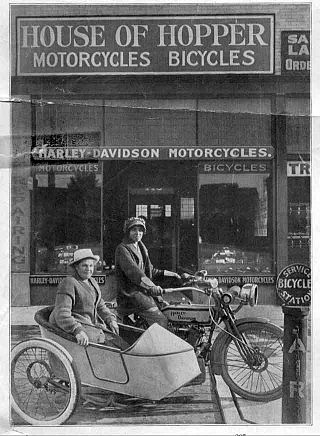
Avis and Effie Hotchkiss, mother and daughter from Brooklyn, New York, were pioneering motorcyclists who completed a 9,000-mile (14,000 km) round trip ride from New York to San Francisco and back on a Harley-Davidson motorcycle-sidecar combination in 1915.
This is a glossary of motorcycling terms.

The Harley-Davidson KR or KR750 was a 45.125 cu in (739.47 cc) displacement V-twin engine racing motorcycle made by Harley-Davidson from 1953 through 1969 for flat track racing. It was also used in road racing in the KRTT faired version. When the KR was first introduced, it dominated motorcycle racing in the United States. In 1970 it was replaced by the long-lived and US race-winning Harley-Davidson XR-750.
Gloria Tramontin Struck is an American motorcyclist who was one of the early members of the Motor Maids women's motorcycle club, which she joined in 1946, at age 21. She is both a Sturgis Hall of Fame and Motorcycle Hall of Fame inductee.
References
- ↑ Becker, Pamela (2023-12-17). "Looking Back: Waterloo's Scherbyn was a motorcycle pioneer". Finger Lakes Times. Retrieved 2024-06-27.
- 1 2 3 4 McKay, Linda Back; Vogl, Kate St Vincent (2023-09-28). Iron Horse Cowgirls: Louise Scherbyn and the Women Motorcyclists of the 1930s and 1940s. McFarland. ISBN 978-1-4766-6946-5.
- ↑ Lahman, Lynda (2016-06-28). The Women's Guide to Motorcycling: Everything a Woman Needs to Know About Bikes, Equipment, Riding, and Safety. Fox Chapel Publishing. ISBN 978-1-62008-210-2.
- ↑ "True Pioneers: Long ago, courageous and sprited women broke down motorcycling barriers". American Motorcyclist. American Motorcyclist Association. June 2006.
- ↑ Holmstrom, Darwin (2020-11-17). Indian Motorcycle: 120 Years of America's First Motorcycle Company. Motorbooks. ISBN 978-0-7603-6653-0.
- ↑ "WIMA Heritage". Women's International Motorcycle Association. Retrieved 2024-06-26.
- 1 2 Winterhalder, Edward; Clercq, Wil De (2014-07-15). Biker Chicz: The Attraction Of Women To Motorcycles And Outlaw Bikers. Blockhead City. ISBN 978-0-9899997-2-4.
- 1 2 Breese, Bonnie J. (2016-05-09). Waterloo. Arcadia Publishing. ISBN 978-1-4396-5618-1.
- ↑ Alford, Steven E.; Ferriss, Suzanne (2008-01-03). Motorcycle. Reaktion Books. ISBN 978-1-86189-475-5.
- ↑ "Women's International M/C Association (WIMA)". Motorcycle Council of NSW. 2022-07-13. Retrieved 2024-06-27.
- ↑ Miller, Ernestine G. (2002). Making Her Mark: Firsts and Milestones in Women's Sports. McGraw Hill Professional. ISBN 978-0-07-139053-8.
- ↑ "ABOUT US". WIMA World. 2024-08-19. Retrieved 2024-06-27.
- 1 2 Zimmer, Melanie (2009-08-28). Forgotten Tales of New York. Arcadia Publishing. ISBN 978-1-61423-541-5.